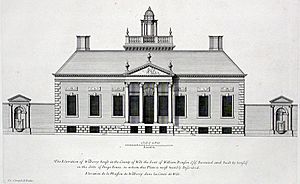William Benson (architect) facts for kids
William Benson (born 1682, died 1754) was a talented architect and a Whig politician in Britain. He was a member of the House of Commons from 1715 to 1719. In 1718, he became the Surveyor of the King's Works, a very important job in charge of royal buildings. However, his time in this role was not very successful.
Contents
Early Life and Travels
William Benson was the oldest son of Sir William Benson, who was the Sheriff of London. When he was young, William went on a "Grand Tour," which was a long trip around Europe that rich young men took to learn about art and culture. He spent a lot of time in Hanover (now in Germany) from 1704 to 1706. This was important because the ruler of Hanover was next in line to become the King of Britain. William tried hard to impress the ruler and his mother, Electress Sophia. He even visited Stockholm, which was not a common stop on these tours.
Back in London, he wrote a political paper that supported the Whig party. It warned against people who wanted to bring back the old royal family (called Jacobitism) and argued against the idea that kings had a divine right to rule. This paper was very popular and was even translated into French.
Designing Wilbury House
After his travels, Benson returned to London with new ideas about architecture, especially the "neo-Palladian" style. This style was inspired by the simple, balanced designs of ancient Roman buildings. In 1707, he married Eleanor Earle, whose father was a wealthy merchant. Benson's own father bought him land in Wiltshire.
In 1709, Benson started designing his own home, Wilbury House, on this land. Wilbury House was one of the first examples of the neo-Palladian style in England. It was a modest, one-story house with a classic front porch (called a portico). The house was featured in a famous architecture book called Vitruvius Britannicus in 1715, which gave Benson credit for its design.
Public Service and Parliament
In 1709, Benson became the High Sheriff of Wiltshire. He was also interested in water systems. He helped bring piped water to the town of Shaftesbury. Although another person, Mr. Holland, might have come up with the idea, Benson took the credit. This helped him get elected as a Member of Parliament for Shaftesbury in 1715.
In 1716, Benson traveled with King George I to Hanover. There, Benson helped design waterworks for the King's gardens at Herrenhausen. He even borrowed Mr. Holland's workers for the project. The goal was to create a huge fountain, but it didn't work as well as planned, only spurting water a short distance.
Surveyor of the King's Works
In 1718, William Benson was appointed Surveyor of the King's Works. This meant he was in charge of all royal buildings and construction projects, taking over from the famous architect Sir Christopher Wren. To get this job, he had help from a politician named John Aislabie. Because it was a government job, Benson had to run for Parliament again in Shaftesbury. He won the election in November 1718, but he lost his seat in January 1719 after a challenge.
Benson's time as Surveyor was difficult. He fired many skilled workers and argued with his colleagues. He also made the Treasury (the government's money department) very angry. He even falsely claimed that the House of Lords chamber was about to collapse, which upset them greatly. The only lasting work done during his time as Surveyor was a set of state rooms at Kensington Palace. He was removed from his position in July 1719.
Later Life
After losing his job as Surveyor, Benson helped with the design of Stourhead, a famous garden, for his brother-in-law, Henry Hoare. The famous poet Alexander Pope made fun of Benson in his poem The Dunciad for honoring a minor writer with a statue while also honoring the great poet John Milton.
Benson tried to get back into Parliament for Shaftesbury in 1727, but he only received a few votes. After this, he cut off the water supply to the town! In 1734, he sold Wilbury House and moved to Wimbledon.
In 1735, he took on another important government job called Auditor of the Imprests, which he held until he died. William Benson passed away on February 2, 1754. He had several children from his two marriages.


